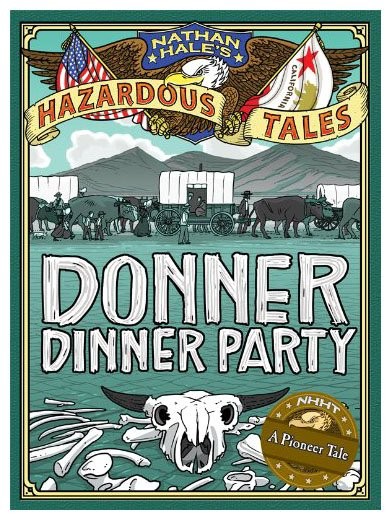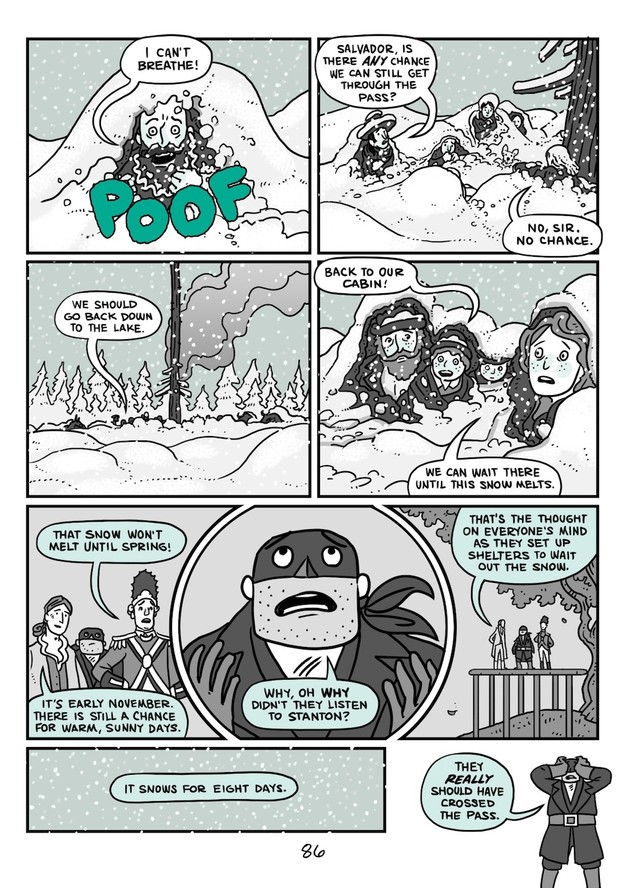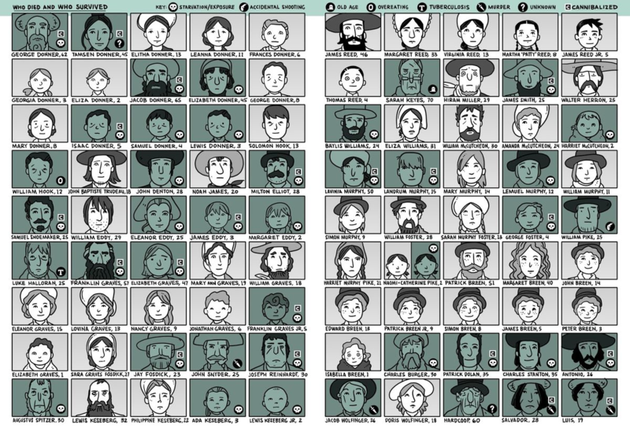“Nathan Hale’s Hazardous Tales: Donner Dinner Party” (10 out of 10) Nathan Hale, 2103. Abrams Books.
2012 saw the debut of a new line of children’s history books, told in graphic novel format. The books are written and illustrated by a guy with the historically fortuitous name Nathan Hale. Taking a cue from his own name, Mr. Hale has the books narrated by the historic Nathan Hale, executed by the British for espionage in 1776. Nathan Hale, his own Hangman, and the British Provost form a kind of triad narrator, chiming in with their own opinions and asides as the historic tales unfold. The first two books were One Dead Spy, telling Nathan Hale’s own story as part of the American Revolution, and Big Bad Ironclad about the first ironclad ships used in the American Civil War. The third book just came out in 2013, and I’ve read it a few times, and recommended it to every teacher and parent and history buff I can find. And now you.

With a title like “Donner Dinner Party,” I’m guessing adults will cringe, and kids will um…eat it up. The book tells the story of the doomed Donner-Reed Party, who was traveling from the midwest to California in 1846. As with the previous two books, “Donner Dinner Part”y is about more than just that expedition, but about Westward Expansion on the whole–in brings in information about the Black Hawk War, the Gold Rush, the Oregon Trail and Mormon pioneers, and just how dangerous it was for any group to move west, not just the Donner Party.
From the first chapter, Hale establishes that James Reed is something of a buffoon, pretentious and preening, and making foolish choices. He’s able to do that in a fairly even-handed way, balancing the foolishness with the sort of “pioneering spirit” that we like to think Americans have. Reed, one of the leaders of the Donner-Reed Party, will be a source of comic relief–but also a serious threat–for much of the book. In Chapter 2, Reed leads his group of wagons into a serious blunder: following the Hastings Cutoff. A shortcut promoted by Lansford Hastings, who had never even been on the route he was touting, it’s probably what caused the death of so many in the Donner-Reed Party. Instead of following the well-traveled path of the Oregon Trail, it led them through the mountains of Utah and the deserts of the Great Basin (including the Great Salt Lake Desert), some of the least hospitable land in the entire continent.
The first dramatic death is Billy the Pony, The Hangman, who loves cute little animals (even though his career is executing men) is sure “he went and found a nice meadow to live in. Right?” But Nathan Hale tells him, “Billy most likely ended up as dinner for someone farther down the wagon train. Fresh meat shouldn’t be wasted.” The Hangman responds with a full page “NOOOOOOOO!!”, his fingers clenched, his face a rictus of horror. It’s a nice way of letting the reader experience the emotion, but also laugh at themselves a little, and eases the tension a little…because things are going to get much worse.
The first dramatic death is Billy the Pony.
There are several places where Nathan Hale (the narrator) warns the reader that this isn’t a happy story, and things are going to get worse. He even tells us that we can skip ahead to page 113 if we want to get away from the worst of it. But of course, we don’t.

When you hear the phrase “Donner Party,” besides thinking of cannibalism, you probably think of a small group of people. A two-page spread on pages 42-43 shows us how many people there really were, and how the 81 of them were arranged in groups of ten families, with nineteen wagons, each with four oxen needed to pull it. It’s one of the many times in these books where the pictures really help to understand the story, and even though I’ve read several books about the Donner Party, this one ended up being one of the better ones.
Once the group is stranded in the Sierra Nevada mountains, the deaths start coming quickly. Hale (the author/illustrator) uses the classic Grim Reaper imagery to show the taking of lives, and is somehow able to let the reader experience the grief and the solemnity of being forced to cannibalize the flesh of someone who’s died without being too horrific about it. It’s not graphic, but it’s still disturbing. Even then, when it gets to the cannibalism, the Hangman is able to bring a little bit of humor–but also a reality of life in the past–that we often overlook in discussions of The Donner-Reed Party. I won’t spoil what it was, but it’s on page 104, if you’re looking.
One boy actually died from overeating.
As a history teacher, one of the things I love about these books is that Hale tells you about the research that he does in order to write the books. He includes tools found in other (non graphic novel) history books, like a good bibliography, biographies of major characters in the book, and questions that might be raised while you’re reading the book. In this case, there are also a few one-page mini comics that explain some of those. A case in point: one boy who was a part of the Donner-Reed Party, William Hook, actually died from overeating. Hale explains how that happened. There’s also a two-page “Who Died and Who Survived” chart that looks almost like a periodic table of everyone in the party, including how they died and whether or not they were eaten after they died. It’s a little creepy, a little morbid, but not as disturbing as you’d expect. Another part of the appendix is a one page story “By the Hangman” that made me laugh out loud…and does some healing for those who were too saddened or traumatized by the story of the Donner-Reed Party, and needed to cleanse their palate.

This book, like the first two in this series, is fantastic. It makes for good reading, it’s historically valid, and it’s able to tell a very serious story in a way that’s informative and entertaining. I was wondering if Hale would be able to tell such a tragic story without making light of the people involved, and he does so admirably. I loved this book. You don’t need to read the first two in the series to understand why the historic Nathan Hale and his executioners are narrating a Donner Party story, but the characters do get more interesting over the course of the books. Whether you’re a kid or adult, whether you like history, or are morbidly curious about one of the most famous tragedies in the American West, you’ll probably enjoy “Donner Dinner Party.” Bring the dessert.